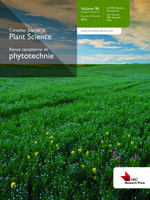Lafrenière, C. and Drapeau, R. 2011. Seeding patterns and companion grasses affect total forage yield and components of binary red clover-grass mixtures. Can. J. Plant Sci. 91: 91-97. Red clover (Trifolium pratense L.) is the most popular seeded legume for forage production in northern Quebec and Ontario because of the poorly drained soils that prevail in these regions. The objective of this experiment was to determine which seeding patterns [mixed within a row (MR), single alternate rows (1 1), or double alternate rows (2 2)] and which companion grasses (smooth bromegrass, Bromus inermis L.; tall fescue, Festuca arundinacea Schreb.; orchardgrass, Dactylis glomerata L.; or timothy, Phleum pratense L.), in association with red clover, were best for sustaining the total forage yield of a red clover-grass mixture and how these factors affect red clover and grass components. Test plots were established at Kapuskasing, ON, and Normandin, QC. At each site, two independent seedings were performed and harvested over 3 yr following the seeding year. Total dry matter (DM) yield and contribution of red clover grasses and weeds to total forage yield were measured. The MR pattern gave higher yield over both alternate seeding patterns by nearly 0.5 Mg DM ha-1 at the Normandin site and 1.0 Mg DM ha-1 at the Kapuskasing site. Neither the seeding pattern nor the companion grass species improved significantly the contribution of red clover to total forage yield beyond the second production year even though there were differences between sites. Environmental conditions, principally high precipitation in the fall, and maturity stage at harvest resulted in major differences between sites. Results from this experiment showed that tall fescue and orchardgrass could be good alternatives to timothy or bromegrass in association with red clover given that plots were still productive in the third production year and invasion by weeds was lower.
How to translate text using browser tools
1 January 2011
Seeding patterns and companion grasses affect total forage yield and components of binary red clover-grass mixtures
Carole Lafreniére,
Raynald Drapeau
ACCESS THE FULL ARTICLE
It is not available for individual sale.
This article is only available to subscribers.
It is not available for individual sale.
It is not available for individual sale.
brome inerme
dactyle pelotonné
fétuque élevée
fléole des prés
orchardgrass
patron de semis
red clover





